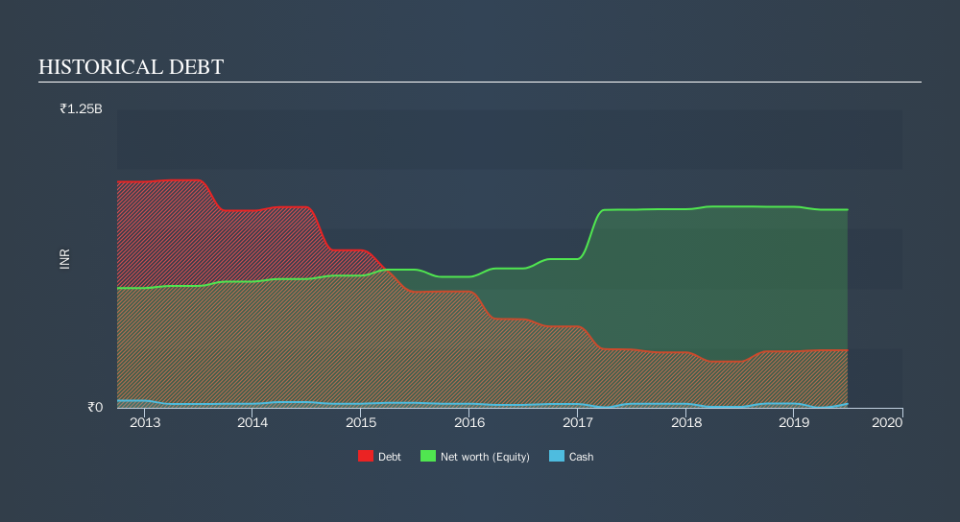Is CIL Nova Petrochemicals (NSE:CNOVAPETRO) A Risky Investment?

Legendary fund manager Li Lu (who Charlie Munger backed) once said, 'The biggest investment risk is not the volatility of prices, but whether you will suffer a permanent loss of capital. So it might be obvious that you need to consider debt, when you think about how risky any given stock is, because too much debt can sink a company. Importantly, CIL Nova Petrochemicals Limited (NSE:CNOVAPETRO) does carry debt. But the more important question is: how much risk is that debt creating?
When Is Debt Dangerous?
Debt and other liabilities become risky for a business when it cannot easily fulfill those obligations, either with free cash flow or by raising capital at an attractive price. Ultimately, if the company can't fulfill its legal obligations to repay debt, shareholders could walk away with nothing. However, a more frequent (but still costly) occurrence is where a company must issue shares at bargain-basement prices, permanently diluting shareholders, just to shore up its balance sheet. Of course, the upside of debt is that it often represents cheap capital, especially when it replaces dilution in a company with the ability to reinvest at high rates of return. When we examine debt levels, we first consider both cash and debt levels, together.
See our latest analysis for CIL Nova Petrochemicals
What Is CIL Nova Petrochemicals's Net Debt?
You can click the graphic below for the historical numbers, but it shows that as of March 2019 CIL Nova Petrochemicals had ₹240.8m of debt, an increase on ₹193.6m, over one year. However, it also had ₹16.9m in cash, and so its net debt is ₹223.9m.
How Healthy Is CIL Nova Petrochemicals's Balance Sheet?
The latest balance sheet data shows that CIL Nova Petrochemicals had liabilities of ₹731.9m due within a year, and liabilities of ₹109.6m falling due after that. Offsetting this, it had ₹16.9m in cash and ₹402.1m in receivables that were due within 12 months. So its liabilities outweigh the sum of its cash and (near-term) receivables by ₹422.5m.
This deficit casts a shadow over the ₹250.4m company, like a colossus towering over mere mortals. So we'd watch its balance sheet closely, without a doubt At the end of the day, CIL Nova Petrochemicals would probably need a major re-capitalization if its creditors were to demand repayment. When analysing debt levels, the balance sheet is the obvious place to start. But you can't view debt in total isolation; since CIL Nova Petrochemicals will need earnings to service that debt. So when considering debt, it's definitely worth looking at the earnings trend. Click here for an interactive snapshot.
Over 12 months, CIL Nova Petrochemicals made a loss at the EBIT level, and saw its revenue drop to ₹2.3b, which is a fall of 12%. That's not what we would hope to see.
Caveat Emptor
While CIL Nova Petrochemicals's falling revenue is about as heartwarming as a wet blanket, arguably its earnings before interest and tax (EBIT) loss is even less appealing. Indeed, it lost ₹15m at the EBIT level. When we look at that alongside the significant liabilities, we're not particularly confident about the company. It would need to improve its operations quickly for us to be interested in it. Not least because it burned through ₹37m in negative free cash flow over the last year. So suffice it to say we consider the stock to be risky. When we look at a riskier company, we like to check how their profits (or losses) are trending over time. Today, we're providing readers this interactive graph showing how CIL Nova Petrochemicals's profit, revenue, and operating cashflow have changed over the last few years.
Of course, if you're the type of investor who prefers buying stocks without the burden of debt, then don't hesitate to discover our exclusive list of net cash growth stocks, today.
We aim to bring you long-term focused research analysis driven by fundamental data. Note that our analysis may not factor in the latest price-sensitive company announcements or qualitative material.
If you spot an error that warrants correction, please contact the editor at editorial-team@simplywallst.com. This article by Simply Wall St is general in nature. It does not constitute a recommendation to buy or sell any stock, and does not take account of your objectives, or your financial situation. Simply Wall St has no position in the stocks mentioned. Thank you for reading.


